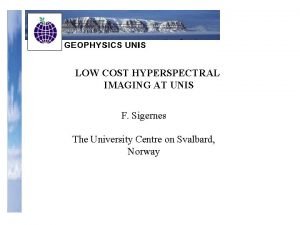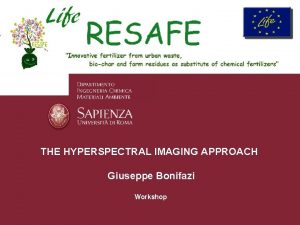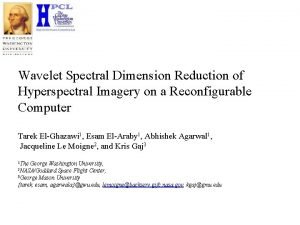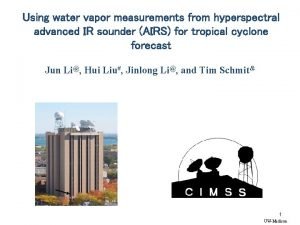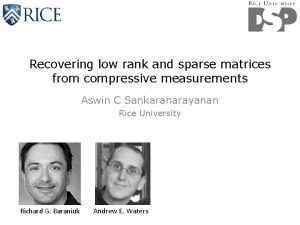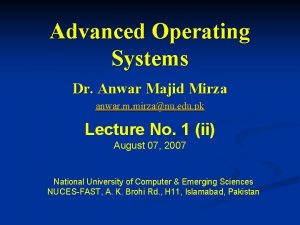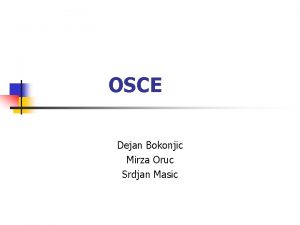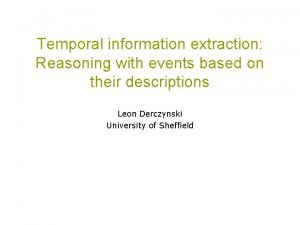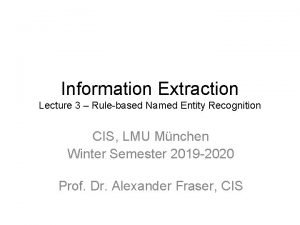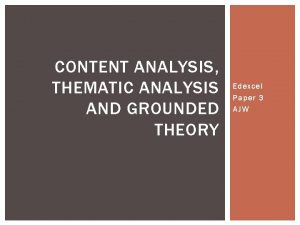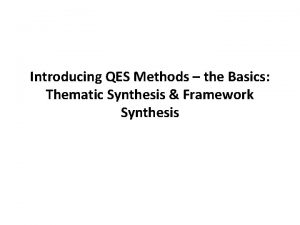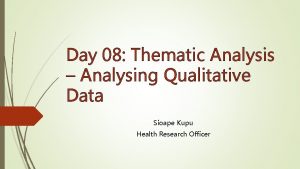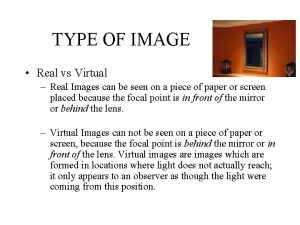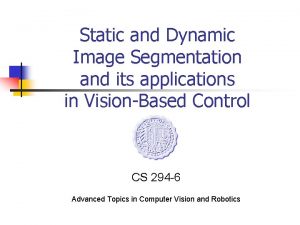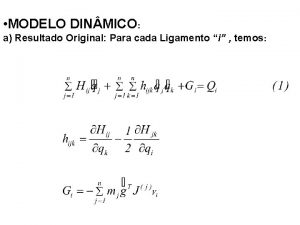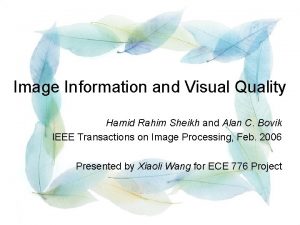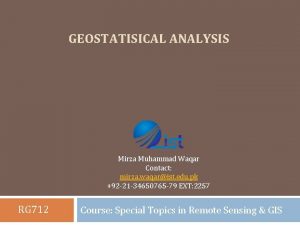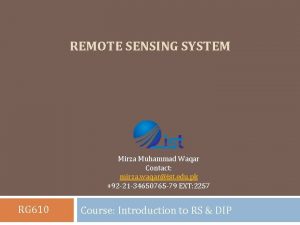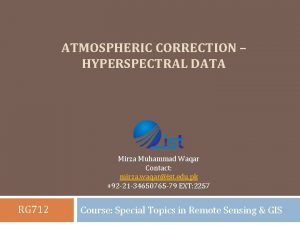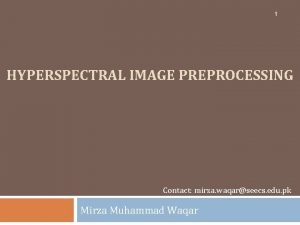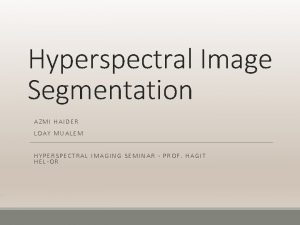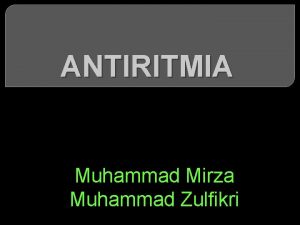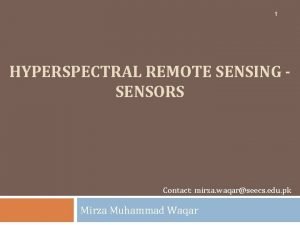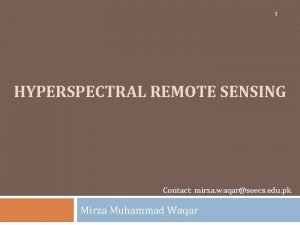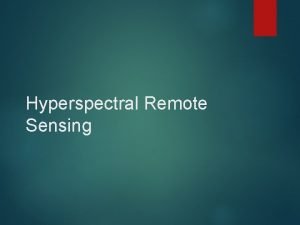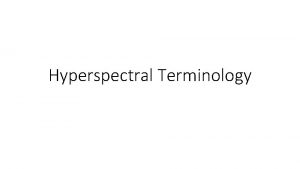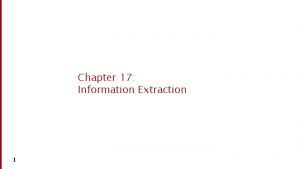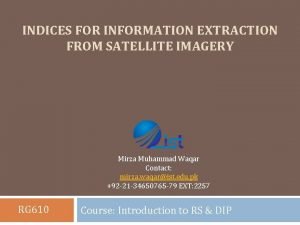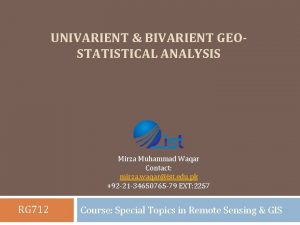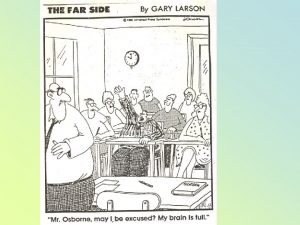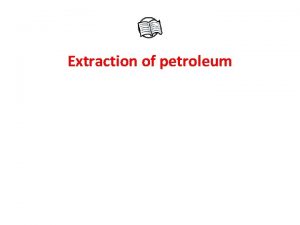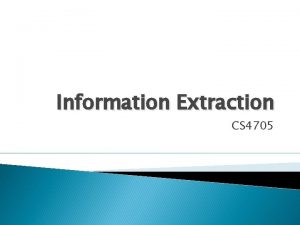THEMATIC INFORMATION EXTRACTION HYPERSPECTRAL IMAGE ANALYSIS Mirza Muhammad






























































- Slides: 62

THEMATIC INFORMATION EXTRACTION – HYPERSPECTRAL IMAGE ANALYSIS Mirza Muhammad Waqar Contact: mirza. waqar@ist. edu. pk +92 -21 -34650765 -79 EXT: 2257 RG 712 Course: Special Topics in Remote Sensing & GIS

Outlines Imaging Spectrometry Multispectral versus Hyperspectral Image Acquisition Extraction of information from Hyperspectral data � Preprocessing of Data Subset Study Area Initial Image Quality Assessment � Radiometric Calibration � � Visual Individual Band Examination Visual Examination of Color Composite Animation Statistical Individual Band Examination In situ data Radiosounder Radiative Transfer based Atmospheric Correction Selected Atmospheric Correction Models Reducing Data Redundancy Endmember Determination Hyperspectral Mapping Method

Imagining Spectrometry Imagining spectrometry is defined as � � � the simultaneous acquisition of images in many relatively narrow contiguous and/or noncontiguous spectral bands throughout the ultraviolet, visible, and infrared portions of electromagnetic spectrum”

Hyperspectral vs Multispectral Most multispectral � 3 to 10 spectral bands � For Example Landsat (MSS, TM & ETM+) ALOS SPOT (HRV) IKNOS Quick. Bird Orbview Digital Globe Worldview Aerial phtography Hyperspectral � At least 10 or more spectral bands � Example includes: MODIS MERIS (Envisat) MOS (IRS-3 P, India) Hyperion (EO-1) CHRIS (PROBA, ESA) AVIRIS (JPL, NASA) DAIS 7915 (DLR) HYDICE (NRL, USA)

Hyperspectral Image Acquisition Spectrometer

Hyperspectral Image Acquisition

Extraction of Information from Hyperspectral Data 1. Selection of appropriate Software Package 2. Image Quality Assessment 3. Radiometric Correction 4. Geometric Correction 5. Dimensionality Reduction 6. Selection of end members 7. Mapping methods

Selection of appropriate Software Package The analysis of hyperspectral data usually required selection of appropriate digital image processing software package e. g. ENVI, the Environment for Visualizing Images ERDAS Imagine IDRISI PCI Geomatica

Geometric Correction Band Selection Atmospheric Correction End Member Selection Classification SAM Accuracy Assessment

State the nature of the information extraction problem 1. Specify the geographical ROI 2. Define the classes or biological materials of interest Acquire appropriate remote sensing and initial 1. 2. 3. 4. 5. ground ref data Select RS data based on the following criteria 1. RS system consideration: 1. Spatial, spectral, temporal & radiometric resolution 2. Environmental considerations: 1. Atmospheric, soil moisture, phonological cycle, etc. 3. Obtain initial ground reference data based on: 1. A priori knowledge of the study area Perform accuracy assessment Select method 1. Qualitative confidence building 2. Statistical measurement Determine number of observations required by class Select sampling scheme Obtain ground reference data Create and analyze error matrix: 1. Uni-varitae and multivariate statistical analysis Accept or reject previously stated hypothesis. Distribute result if accuracy is acceptable. 1. 2. 3. 4. 5. 6. 7. information Subset the study area Conduct initial image quality assessment: 1. Visual individual band examination 2. Visual examination of color composite images 3. Animation 4. Statistical individual band examination (S/N ratio) Radiometric Correction 1. Collect necessary in situ spectroradiometer data (if possible) 2. Collect in situ or environmental data (e. g. using radio sounder) 3. Perform pixel by pixel correction (e. g. ACORN) 4. Perform pixel by pixel spectral polishing 5. Empirical Line Calibration Geometric Correction / Rectification 1. Use onboard navigation and engineering data (GPS & INS Data) 2. Nearest neighbor resampling Reduce the dimensionality of hyperspectral data 1. Minimum Noise Fraction (MNF) transformatoin End Member determination – locate pixels which relatively pure spectral characteristics: 1. Pixel Purity Index 2. N-dimensional end member visualization Method of mapping and matching using hyperspectral data: 1. Spectral Angle Mapper (SAM) 2. Subpixel Classification (Linear Spectral Mixing 3. Spectroscopic library matching techniques 4. Matched filter or mixture-tuned matched filter 5. Indices developed for use with hyperspectral

Initial Image Quality Assessment To assess the data quality, suitable distortion measures relevant to end-user applications are required. 1. 2. 3. 4. Visual Individual Band Examination Visual Examination of Color Composite Images Animation Statistical Individual band Examination

1. Visual Individual Band Examination Many bands of hyperspectral data contain � bad data values or they lie in the absorption window. Such bands must be excluded from the analysis because these reduce the contrast of data. Bad Data � If a band contain data values (e. g. -9999) � Line dropout (an entire line has a value of -9999)

1. Visual Individual Band Examination Reference: Jun Huang, Helle Wium, Karsten B. Qvist, Kim H. Esbensen, Multi-way methods in image analysis—relationships and applications, Chemometrics and Intelligent Laboratory Systems, Volume 66, Issue 2, 28 June 2003, Pages 141 -158, ISSN 0169 -7439, 10. 1016/S 01697439(03)00030 -3. (http: //www. sciencedirect. com/science/article/pii/S 0169743903000303) Keywords: Multivariate Image Analysis (MIA); Multiway methods; Unfolding; Image; PCA/PLS; PARAFAC; Tucker 3; N-PLS; 2 -D FFT

2. Visual Examination of Color Composites Can be use to check � The individual bands are co-align � Contain spectral information of value Such examination provide � Valuable quantitative information About the individual scenes and bands in the hyperspectral data

2. Visual Examination of Color Composites

3. Animation Most hyperspectral image analysis software have image animation function. � E. g. every 5 second a new band will be displayed Examination of hyperspectral data in this way allows: � Identify individual bands that have serious atmospheric attenuation � Determine if any mis-registration of band exist

4. Statistical Individual Band Examination It includes examination of uni-variate statistics of individual band � Mean � Median � Mode � Standard Deviation � Range To detection absorption feature � Noise level must be smaller than the absorption level.

Radiometric Calibration To use hyperspectral data properly � It is generally accepted that the data must be radiometrically corrected. This process normally involves transforming the hyperspectral data from at-sensor radiance, to scaled surface reflectance. This allows image spectra comparable with the in situ spectra � Obtained quantitatively using handheld spectroradiometer.

Digital Number (DN) – the unitless integer that a satellite uses to record relative amounts of radiance (e. g. 0 – 255 where 0 = no radiance and 255 = some maximum amount of radiance that the sensor is sensitive to). Each image pixel has one DN for each band. Note that DNs are just an index of radiance and don’t have physical units of radiance.

Radiance (L) – the physical amount of light received at a particular place � in this case a satellite (watts/m 2/sr).

Irradiance (E) – the amount of incoming light from the sun (either at the ground (E) or at the top of the atmosphere (E 0 or TOA) (watts/m 2).

Reflectance (r) – the amount of light that reflects off of something divided by the amount of incoming light (often given as a decimal fraction or a percent). Also called surface reflectance

Apparent Reflectance (Albedo), Reflectance Apparent Reflectance (Albedo) "Albedo is defined as the fraction of incident radiation that is reflected by a surface. Reflectance While reflectance is defined as this same fraction for a single incidence angle, albedo is the directional integration of reflectance over all sun -view geometries. "

1. In Situ Data Collection For Hyperspectral Image Analysis, � It is always desirable to obtain handheld in situ spectrometer measurement on the ground at Approximately same time as the remote sensing over flight Otherwise same time of day That cover the spectral range as the hyperspectral imaging system Spectrometer used in the field must be calibrated with reference spectrometer � (laboratory spectrometer)

2. Radiosondes Radiosonders can provide valuable information about the atmosphere � Tempearture � Pressure � Relative Humidity � Wind Speed � Ozone � Wind Direction Radiosonder data helps in radiometeric correction.

3. Radiative Transfer-based Atmospheric Correction As atmosphere is variable through the scene. � Ideally, the analyst knows the exact nature of atmospheric characteristics over each pixel. Barometric Pressure Water vapor Amount of atmospheric molecules (Scattering) Remotely sensing – derived radiance data in very selective bands can be used � for pixel by pixel atmospheric correction.

Behaviour of Atmospheric Gases Following seven gases do produce observable absorption in the remotely sensed imagery. 1. 2. 3. 4. 5. 6. 7. Water vapour, H 2 O Carbon Dioxide, CO 2 Ozone, O 3 Nitrous Oxide, N 2 O Methane, CH 4 Carbon Monoxide, CO Oxygen O 2

Behaviour of Atmospheric Gases

Band-by-Band Spectral Polishing Even after atmospheric correction there exist noise in spectra � Which is due to sensor system anomilies � Limited accuracy of Standards Measurements Models Calibrations Spectral polishing is used to remove such errors. � EFFORT (Empirical Flat Field Optimal Reflectance Transformation)

Spectral Polishing - EFFORT Input Parameters � � Atmospherically corrected data In situ spectroradiometer spectra In situ spectral reflectance measurements are sometimes referred to as “reality boost spectra”. Note: Before applying EFFORT � � � Mask any invalid data from each band Identify the bad bands and mask these from analysis Avoid wavelength ranges that contain noise such as 1. 4 µm and 1. 9 µm water vapour absorption band.

Selected Atmospheric Correction Models 1. 2. 3. Flat Field Correction Internal Average Relative Reflectance (IARR) Empirical Line Calibration

Flat Field Correction 32 The Flat Field Correction method normalizes images � to an area of known “flat” reflectance (Goetz and Srivastava, 1985; Roberts et al. , 1986). The average AVIRIS radiance spectrum from the ROI is used as the reference spectrum, which is then divided into the spectrum at each pixel of the image.

Internal Average Relative Reflectance (IARR) 33 Used to convert raw DN values to relative reflectance. This is done by dividing each pixel spectrum by the overall average spectrum. The IARR calibration method normalizes images to a scene average spectrum. Apparent reflectance is calculated for each pixel of the image by dividing the reference spectrum into the spectrum for each pixel.

Internal Average Relative Reflectance (IARR) 34 This is particularly effective for reducing imaging spectrometer data to relative reflectance � in an area where no ground measurements exist and little is known about the scene (Kruse et al. , 1985; Kruse, 1988).

Empirical Line Calibration 35 The Empirical Line correction method forces image data to match � selected field reflectance spectra (Roberts et al. , 1985; Conel et al. , 1987; Kruse et al. , 1990). This method based on a model that is derived � from the regression of in situ spectroradiometer measurements at specific location For more detail read: Third Edition – Introductory Digital Image Processing: A Remote Sensing Perspective by John R. Jensen Chapter 6

Geometric Correction

Geometric Correction of Hyperspectral Data

Reducing the Dimensionality of Hyperspectral Data 1. 2. Principal Component Transformation Minimum Noise Fraction Transformation (MNF)

Data Dimensionality The number of spectral bands associated with a remote sensing system is referred to as its data dimensionality. � Orbview: � Landsat: � Worldview: � MODIS: � AVIRIS: 4 bands 7 bands 8 bands 36 bands 224 bands Complexity / Processing Number of Bands

Data Dimensionality: Multispectral Data Statistical measures � Optimum Index Factor (OIF) � Principal Component Analysis (PCA) These techniques have been used for data dimensionality reduction for multispectral data. These methods are not significant for reducing hyperspectral data dimensionality.

Principal Component Transformation Principal components analysis is a method in which original data is transformed into a new set of data � which may better capture the essential information. Often some variables are highly correlated � such that the information contained in one variable is largely a duplication of the information contained in another variable. � Instead of throwing away the redundant data principal components analysis condenses the information in intercorrelated variables into a few variables, called principal components.

Minimum Noise Fraction Transformation (MNF) 42 Hyperspectral Imaging generates vast volumes of data. 100 s or more bands might not be necessary to identify and separate the surface materials of interest to a particular study. Furthermore, some bands might contain more noise than others, making them more of a detriment than an aid to the analysis.

Minimum Noise Fraction Transformation (MNF) 43 Eliminating noise and reducing the spectral dimensionality of the data are the goals of � Principal Component Analysis (PCA) � Minimum Noise Fraction Transformation (MNF). Information contained in individual hyperspectral bands may be, in some regions of the spectrum, highly redundant.

Minimum Noise Fraction Transformation (MNF) 44 The many redundant bands may be collapsed into a much smaller set of MNF bands � without losing the critical information needed to differentiate or identify surface materials. Furthermore, the noise can also be identified and eliminated using the same methods. The MNF is used to determine the true or inherent dimensionality of the hypserpsectral data. � To identify and segregate noise in the data � To reduce the computation time

Minimum Noise Fraction Transformation (MNF) The MNF applies two cascaded PCAs. � First transformation decorrelate and rescales noise in the data Result bands have unit variance and no band to band correlation � Second transformation is a standardize PCA, this results in Coherent MNF eigenimages that information Noise dominated MNF eigenimages contain useful

Minimum Noise Fraction Transformation (MNF)

Minimum Noise Fraction Transformation (MNF) Both the eignvalues and output eignimages are used to determine the true dimensionality of the data. 1. 2. How many eignimages should we select for analysis? What should be threshold for eignvalues? MNF output bands that contain useful information � usually bands. have engine value greater than that of noisy

Minimum Noise Fraction Transformation (MNF) 48

Note 49 MNF results are applicable to that particular dataset or others with very consistent and similar spectral characteristics. If a project involves many hyperspectral images collected over a large area, the MNF results from one image or set of images may not apply to others in the project.

Minimum Noise Fraction Transformation (MNF)

Minimum Noise Fraction Transformation (MNF)

Endmember Determination 1. Pixel Purity Index (PPI) 2. n-dimensional visualization of endmembers in feature space

Endmember Determination The primary goal of most of hyperspectral analysis is to identify the Physical, Chemical � Properties of materials found within the IFOV of the sensor system. � The major materials found within hyperspectral image are called endmembers. � These represents relatively pure materials Water Asphalt Concrete Healthy grass

Pixel Purity Index Mapping (PPI) 54 Imagine how much more difficult it would be to identify appropriate pixels or groups of pixels with ideal hyperspectral signatures. Use Pixel Purity Index (PPI) to find the most spectrally pure (extreme) pixels in multispectral and hyperspectral images.

Pixel Purity Index Mapping (PPI) 55 Pixel Purity Index (PPI) to find the most spectrally pure (extreme) pixels in multispectral and hyperspectral images. PPI is a rigorous mathematical method of determining the most spectrally pure pixels. � By repeatedly projecting n-dimensional scatter plots of the MNF images. � PPI simply identify the most pure pixel. � It is difficult to label the type of endmember at this stage

Pixel Purity Index Mapping (PPI)

Pixel Purity Index Mapping (PPI)

n-dimensional Endmember Visualization

Hyperspectral Mapping Method

Spectral Angle Mapper (SAM)

Hyperspectral Data Acquisition Raw Radiance Data Spectral Calibration At-Sensor Spectrally Calibrated Radiance Spatial Pre-Processing and Geocoding Radiometrically and Spatially processed radiance image Atmospheric Correction, solar irradiance correction Geocoding reflectance image Feature Mapping Data analysis for feature mapping Absorption band characterization 61 Spectral feature fitting Minral Maps Spectral Angle Mapping Spectral Unmixing

Questions & Discussion
 Affordable hyperspectral imaging
Affordable hyperspectral imaging Giuseppe bonifazi
Giuseppe bonifazi Hyperspectral
Hyperspectral Hyperspectral
Hyperspectral Hyperspectral
Hyperspectral الباح
الباح Atiyatul lillahi
Atiyatul lillahi What a thematic statement
What a thematic statement Model bayesian
Model bayesian Anwar majid mirza
Anwar majid mirza The collaborator mirza waheed
The collaborator mirza waheed Anika mirza
Anika mirza Dr dan mirza
Dr dan mirza Concha bullectomy
Concha bullectomy Llxxx
Llxxx 5 interesting facts about volvox
5 interesting facts about volvox Abas mirza
Abas mirza Mirza stitkovac
Mirza stitkovac Mirza oruc
Mirza oruc Mirza zen
Mirza zen Dr atif mirza
Dr atif mirza Sajid mirza
Sajid mirza Dr mirza salman baig
Dr mirza salman baig Ayhan mirza inak
Ayhan mirza inak Text extraction from image
Text extraction from image News item definition
News item definition Temporal information extraction
Temporal information extraction Ner relation extraction
Ner relation extraction Information extraction algorithms
Information extraction algorithms Abductive thematic analysis
Abductive thematic analysis Difference between thematic and content analysis
Difference between thematic and content analysis Abductive thematic analysis
Abductive thematic analysis Difference between thematic and content analysis
Difference between thematic and content analysis Thematic analysis
Thematic analysis Define thematic analysis
Define thematic analysis Thematic coding example
Thematic coding example Methodology triangulation
Methodology triangulation What are real and virtual image
What are real and virtual image Real vs virtual image
Real vs virtual image Image transform in digital image processing
Image transform in digital image processing Linear position invariant degradation
Linear position invariant degradation Compression in digital image processing
Compression in digital image processing Image segmentation in digital image processing
Image segmentation in digital image processing Analog image and digital image
Analog image and digital image Subjective fidelity criteria in digital image processing
Subjective fidelity criteria in digital image processing Image sharpening in digital image processing
Image sharpening in digital image processing Static digital image
Static digital image Geometric transformation in digital image processing
Geometric transformation in digital image processing Gravitational blood drop
Gravitational blood drop The range of values spanned by the gray scale is called:
The range of values spanned by the gray scale is called: Ce n'est pas une image juste c'est juste une image
Ce n'est pas une image juste c'est juste une image Physical image vs logical image
Physical image vs logical image Resultado
Resultado Contra harmonic mean filter
Contra harmonic mean filter Image transforms in digital image processing
Image transforms in digital image processing Imtransform matlab
Imtransform matlab Noise
Noise Xuite
Xuite Oren freifeld
Oren freifeld Image information and visual quality
Image information and visual quality Ventouse chignon
Ventouse chignon Intraalveolar extraction
Intraalveolar extraction Hepatic clearance
Hepatic clearance
